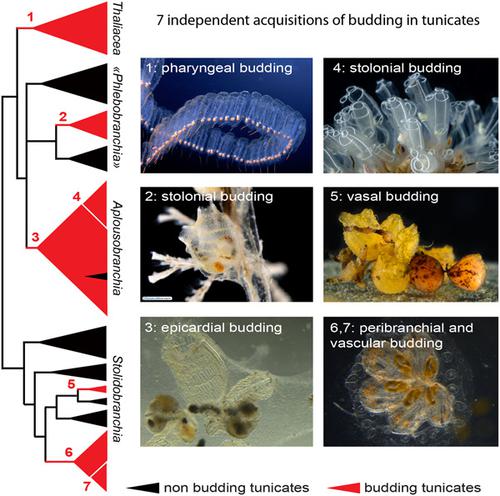当前位置:
X-MOL 学术
›
J. Exp. Zool. B Mol. Dev. Evol.
›
论文详情
Our official English website, www.x-mol.net, welcomes your
feedback! (Note: you will need to create a separate account there.)
The eventful history of nonembryonic development in tunicates
Journal of Experimental Zoology-B: Molecular and Developmental Evolution ( IF 1.8 ) Pub Date : 2020-03-19 , DOI: 10.1002/jez.b.22940 Alexandre Alié 1 , Laurel S Hiebert 1, 2 , Marta Scelzo 1 , Stefano Tiozzo 1
Journal of Experimental Zoology-B: Molecular and Developmental Evolution ( IF 1.8 ) Pub Date : 2020-03-19 , DOI: 10.1002/jez.b.22940 Alexandre Alié 1 , Laurel S Hiebert 1, 2 , Marta Scelzo 1 , Stefano Tiozzo 1
Affiliation

|
Tunicates encompass a large group of marine filter‐feeding animals and more than half of them are able to reproduce asexually by a particular form of nonembryonic development (NED) generally called budding. The phylogeny of tunicates suggests that asexual reproduction is an evolutionarily plastic trait, a view that is further reinforced by the fact that budding mechanisms differ from one species to another, involving nonhomologous tissues and cells. In this review, we explore more than 150 years of literature to provide an overview of NED diversity and we present a comparative picture of budding tissues across tunicates. Based on the phylogenetic relationships between budding and nonbudding species, we hypothesize that NED diversity is the result of seven independent acquisitions and subsequent diversifications in the course of tunicate evolution. While this scenario represents the state‐of‐the‐art of our current knowledge, we point out gray areas that need to be further explored to refine our understanding of tunicate phylogeny and NED. Tunicates, with their plastic evolution and diversity of budding, represent an ideal playground for evolutionary developmental biologists to unravel the genetic and molecular mechanisms regulating nonembryonic development, as well as to better understand how such a profound innovation in life‐history has evolved in numerous metazoans.
中文翻译:

被囊类非胚胎发育的多事之史
被囊类动物包括一大群海洋滤食动物,其中一半以上能够通过一种特殊形式的非胚胎发育 (NED) 进行无性繁殖,通常称为出芽。被囊类动物的系统发育表明无性繁殖是一种进化上的可塑性特征,这一观点因不同物种的萌芽机制不同,涉及非同源组织和细胞这一事实而得到进一步加强。在这篇综述中,我们探索了 150 多年的文献,以提供 NED 多样性的概述,并展示了不同被囊类动物出芽组织的比较图。基于萌芽和非萌芽物种之间的系统发育关系,我们假设 NED 多样性是被囊动物进化过程中七次独立获取和随后多样化的结果。虽然这种情况代表了我们当前知识的最新水平,但我们指出了需要进一步探索的灰色区域,以完善我们对被囊动物系统发育和 NED 的理解。被囊类动物的可塑性进化和萌芽多样性为进化发育生物学家提供了一个理想的场所,可以解开调节非胚胎发育的遗传和分子机制,并更好地了解生命史中如此深刻的创新是如何在众多后生动物中进化的.
更新日期:2020-03-19
中文翻译:

被囊类非胚胎发育的多事之史
被囊类动物包括一大群海洋滤食动物,其中一半以上能够通过一种特殊形式的非胚胎发育 (NED) 进行无性繁殖,通常称为出芽。被囊类动物的系统发育表明无性繁殖是一种进化上的可塑性特征,这一观点因不同物种的萌芽机制不同,涉及非同源组织和细胞这一事实而得到进一步加强。在这篇综述中,我们探索了 150 多年的文献,以提供 NED 多样性的概述,并展示了不同被囊类动物出芽组织的比较图。基于萌芽和非萌芽物种之间的系统发育关系,我们假设 NED 多样性是被囊动物进化过程中七次独立获取和随后多样化的结果。虽然这种情况代表了我们当前知识的最新水平,但我们指出了需要进一步探索的灰色区域,以完善我们对被囊动物系统发育和 NED 的理解。被囊类动物的可塑性进化和萌芽多样性为进化发育生物学家提供了一个理想的场所,可以解开调节非胚胎发育的遗传和分子机制,并更好地了解生命史中如此深刻的创新是如何在众多后生动物中进化的.











































 京公网安备 11010802027423号
京公网安备 11010802027423号